Decorative bricks in the interior of the corridor
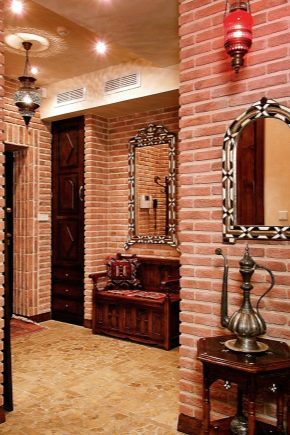
In recent years, it has become quite popular to decorate the walls in the corridor with decorative bricks. And this is not without reason, since such a finish allows you to make the interior more functional and retains its beautiful appearance for a long time.


Pros and cons of using
The decorative brick, which the walls in the hallway are faced with, has quite a few advantages:
- Such a coating will hide all the unevenness of the structures.
- It is durable, does not rub off, as is often the case with wallpaper on protruding parts of rooms.
- This is a fairly light material that will not weigh down the walls, they do not need additional reinforcement.
- A large selection of textures and colors of this finishing material will help you create a unique interior.
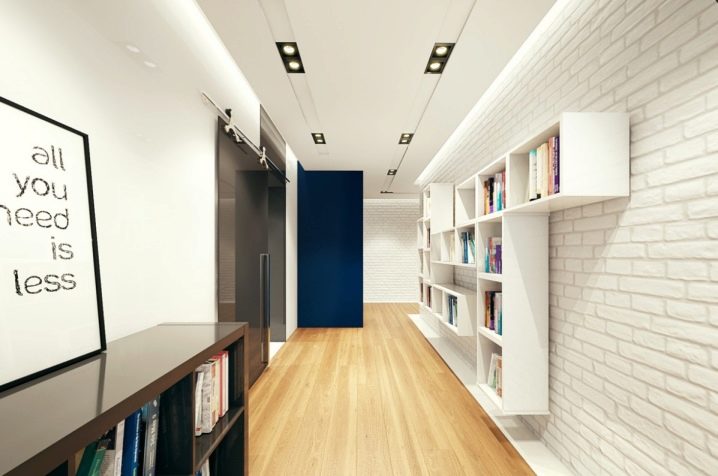
- Decorative bricks are quite easy to clean, dirt and dust from them can be easily wiped off with a damp cloth.
- They are not afraid of changes in humidity and temperature, they will not crack and will not lose their appearance under aggressive environmental influences.
- This coating increases the noise and thermal insulation of the room.
- In the event of damage to one or more fragments of masonry, it is possible to replace only these elements without dismantling the entire wall.
- The prices for this facing material are different, and everyone will be able to pick up a decorative brick for themselves.
But such brickwork also has disadvantages. The main one is that some types of this coating are quite fragile and one must be extremely careful when laying them.
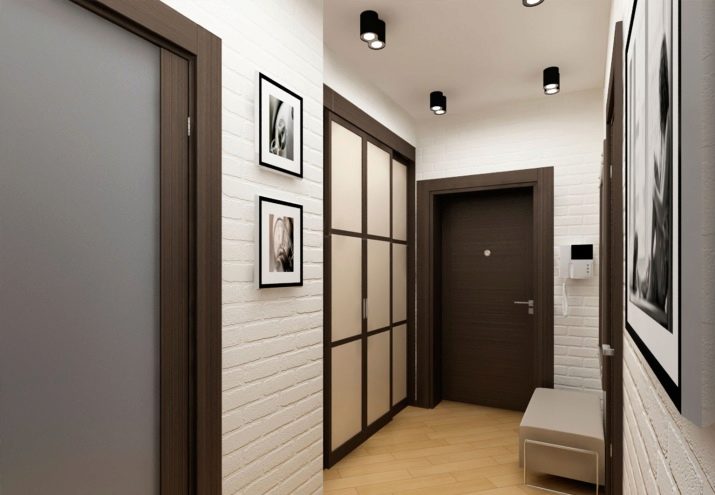
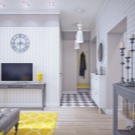
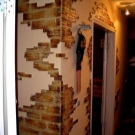
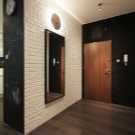

Varieties
There are a lot of types of artificial bricks on the building materials market that are used for interior decoration of houses, and in particular, corridors, and you must first figure out how they differ.
Clinker tiles
Quite often, decorative bricks are called clinker tiles... It is a kind of ceramic material that has a rough or smooth surface. It is lightweight, quite durable, has a minimal thickness and rich colors.
This type of decorative finish is perfect for facing fireplaces and stoves, if they are installed in the hall, as it is heat-resistant.

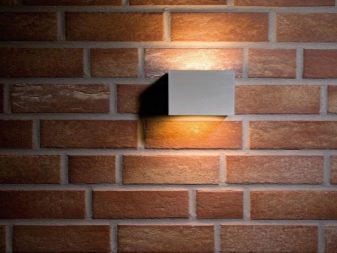
From cement
Another type of decorative brick can be attributed cement products... This material is made by hand by mixing a solution of sand, clay and water and shaping it using formwork. Such a finishing material resembles an ordinary brick, but unlike its counterpart, it is quite fragile and you need to be especially careful with it when laying. But the surface of this finish turns out to be very interesting, textured.
True, when leaving with cement bricks, you need to remember that you should not moisten this material too much, otherwise it may simply deteriorate, in addition, the use of any chemicals for cleaning it is also prohibited.

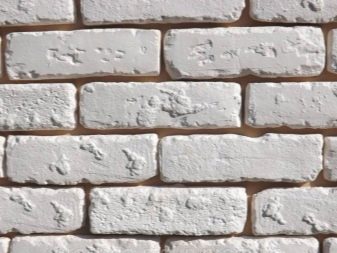
This material is environmentally friendly, does not cause allergies. Cement brick walls can breathe freely. The disadvantage of such a coating is that when laying this material, a lot of dust and debris is formed, as well as the fact that during operation it is necessary to maintain a constant air humidity of no more than 50% to preserve the integrity of the fragments.
Recently, to improve the operational properties in the production of cement bricks, manufacturers have added various polymers, marble and granite chips.
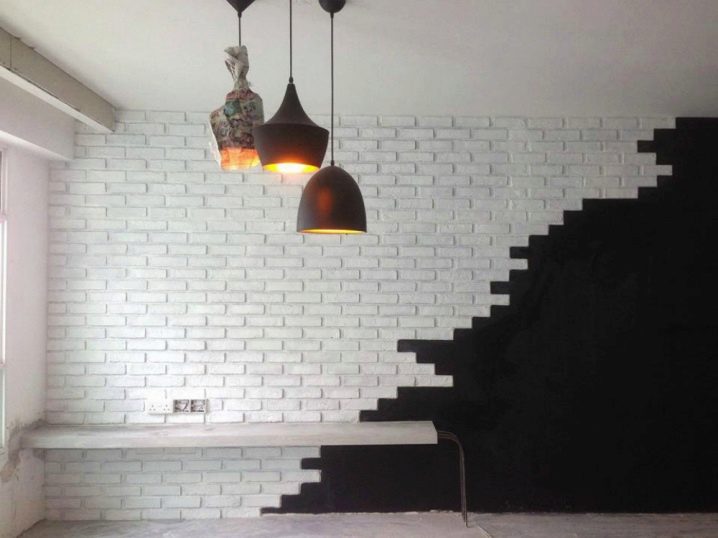
Gypsum stone
Another type of decorative brick is gypsum stone. This is the most inexpensive of the materials presented here for decorating corridors, halls and hallways. It weighs very little, so you can even mount it on drywall sheets. The disadvantages of this material are its fragility and the need for fairly dry air (here the room humidity should also not exceed 50%).
With an increased rate, the bricks can simply become fragile and collapse. But modern technology has practically solved this problem. After finishing the wall, this material is coated with a special varnish with a water-repellent effect, and this procedure significantly increases the service life of the gypsum brick.

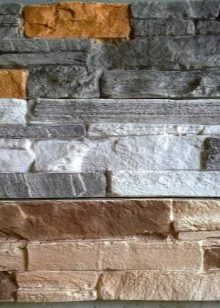
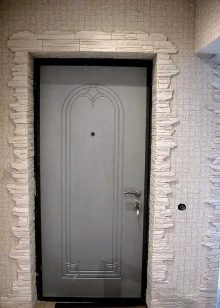
Flexible tiles
Flexible brick-like tiles allow you to decorate rooms both inside and outside. It perfectly resists temperature and humidity extremes, has high sound insulation performance. It is easy to lay such a tile, it does not crumble, it bends well, therefore it does not require a completely flat surface.
If there are columns in your corridor and you want to decorate them with brickwork, this material will be your irreplaceable assistant, as it easily bends around all corners and circles.
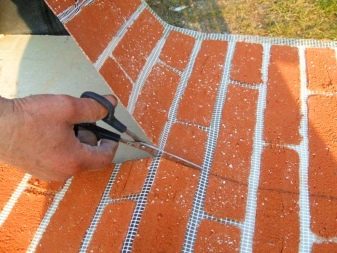
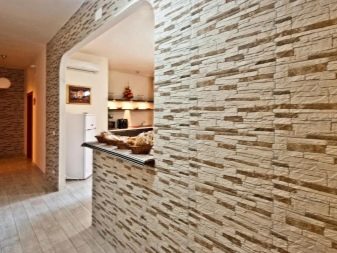
Panels
You can also buy whole panels that imitate brickwork from various materials: MDF, PVC, fiberglass concrete. This will facilitate the work of laying this facing material, especially if you cover all the walls of the corridor with it.
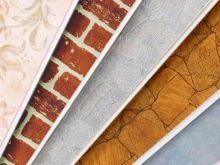
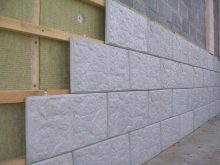
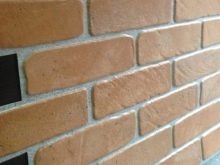
Room decoration methods
You can decorate the walls of the corridor in different ways.
Several techniques are used for this:
- The entire room can be cladded. For this, all walls are covered with brickwork from ceiling to floor along the perimeter of the room.
- You can decorate only one wall with decorative bricks, and paint the rest with paint or wallpaper.
- Also, quite often, with the help of such laying, especially protruding parts of the corridor layout are protected. This cladding protects the wallpaper and paintwork from abrasion.
- With the help of this material, you can focus on certain details of the interior, for example, highlight the door or overlay the location of the mirror with such material, lay out the arch.
- It is quite popular to imitate destroyed surfaces on the walls using this facing material. For this, the walls are not laid entirely with the material, but only from below, changing the height of the cladding in such a way as to imitate a collapsed wall.
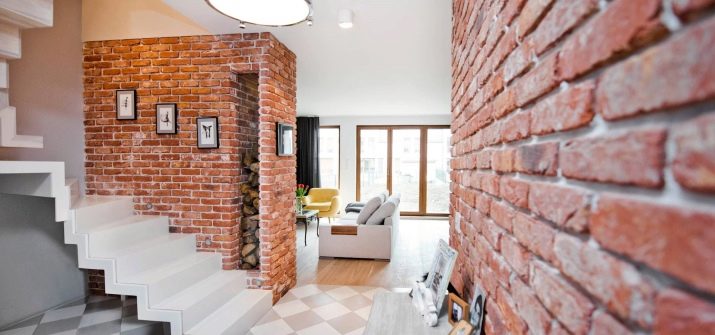

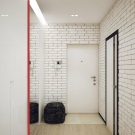
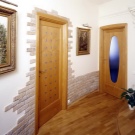
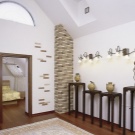

Styles
A brick wall is a fairly popular decor element in many modern corridor design styles.
Here are a few of them, where this type of finish is an integral part:
- Pop Art. This style is dominated by bright colors. It is better to lay the wall here with bricks of a natural terracotta shade, and you can reinforce this cladding with a picture in orange tones or bright textiles on the bench.
- Loft. The factory style also does not do without a brick wall. Here the cladding can be of any color - from white, white-gray to dark brown. It will go well with a pipe hanger or a gray concrete ceiling.
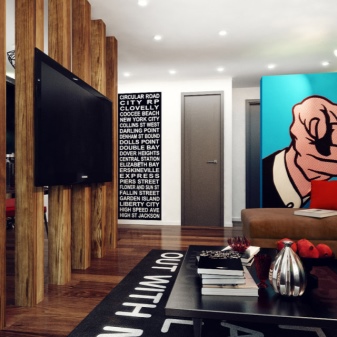
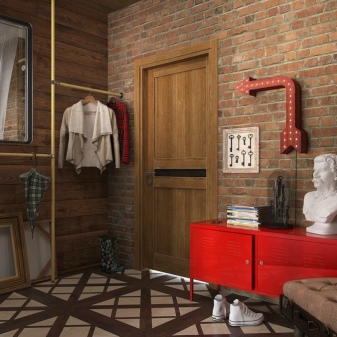
- High tech. This style also allows the use of brickwork on the wall. Here it should be neat, its surface close to perfect.
- Country style a brick wall, if used, should imitate as much as possible a natural coating, moreover laid out by non-professionals, with different thicknesses of seams, with possibly clay smeared over the surface. This will create a rustic look in the interior.
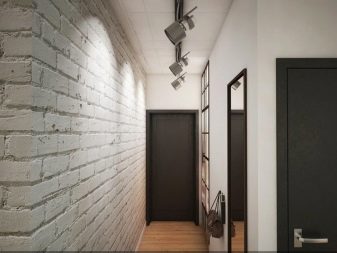
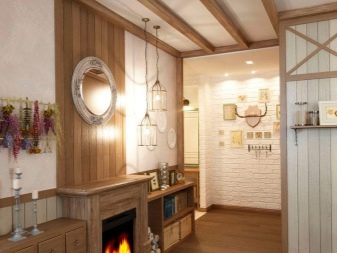
- Scandinavian style also you can find a place for such wall cladding in the corridor.She will give the interior austerity, while adding the influences of past centuries.
- In gothic or ethno-interiors a cold brick wall would also work.
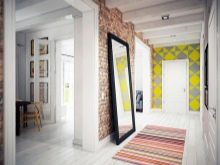
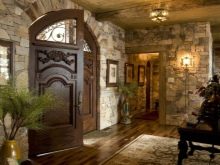

Color spectrum
The color range of decorative bricks for finishing corridors is quite extensive. The choice of colors depends only on personal preferences and the intended design of this room. Many people think that the corridor is a dark enough area to add light. In this regard, a brick of white or a tone close to white with a beige or gray tint is used for wall decoration.
It is true that such colors can make the room lighter, in addition, these shades are able to visually enlarge the often narrow corridors of our apartments, making them visually more extensive.
White brick will give a more noticeable effect if you choose it with a glossy finish. In addition, light colors are refreshing, making the interior of the closed space of the corridor lighter.
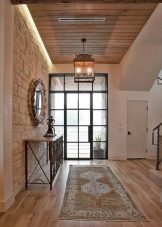
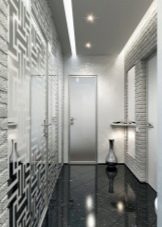
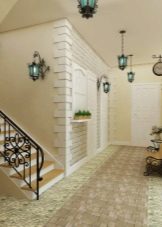
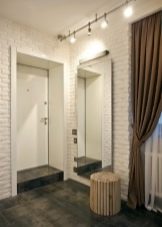
Some, on the contrary, choose a darker color for decorative bricks. This is due to the fact that in the corridors and hallways the walls get dirty quickly enough with dirty shoes, bicycles, strollers and many others, and the dirt on the white coating will be immediately noticeable. And dark tones are able to disguise it, especially since some types of coatings are quite capricious in terms of contact with water.

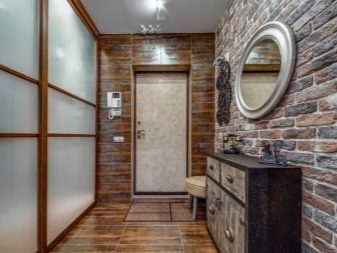
Both light and dark decorative bricks can be either monochromatic or with all kinds of inclusions, thus imitating natural brickwork. Such a brick is rather difficult to match by color. Therefore, now in hardware stores you can purchase a special coating that allows you to smooth out color differences, in addition, it can hide even small defects and chips on the surface of the bricks.
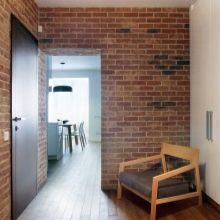
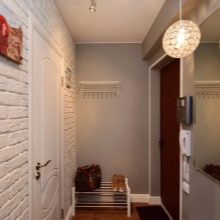

Simulation options
Many people wonder how you can imitate the masonry on the corridor wall with white brick yourself. This is quite simple to do. There are several ways to help you do this design.
If you live in a brick house and the partitions of your home are also made of bricks, then you just need to clean the wall of plaster. To do this, you can use a grinder and remove the entire layer of the topcoat, reaching the cherished masonry. Then you should clean the surface of the wall from dust and dirt. To do this, you need to buy a special oxygen-containing composition, which will also help remove the remnants of the cement mortar, and treat the entire surface with it.
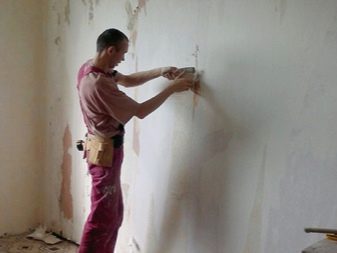

Then you need to align the seams between the bricks, giving them a more presentable look. This can be done with grout or putty.
Then the wall needs to be rinsed and primed. Allow the surface to dry completely, then cover it with a water-based varnish. Then you need to paint the wall white and varnish it again. At the same time, the topcoat can be chosen with both a glossy and a matte sheen.
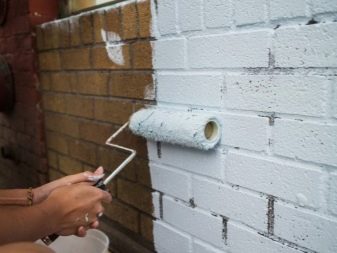

From pieces of polystyrene, you can cut the necessary bricks, use a screwdriver to change the flat surface of this material, thereby simulating a chipped brick, glue the parts to the wall at a distance and paint the wall white, covering it with varnish in the final. This option is suitable for finishing temporary dwellings, as well as country houses - a fairly cheap way to simulate a white brick wall.
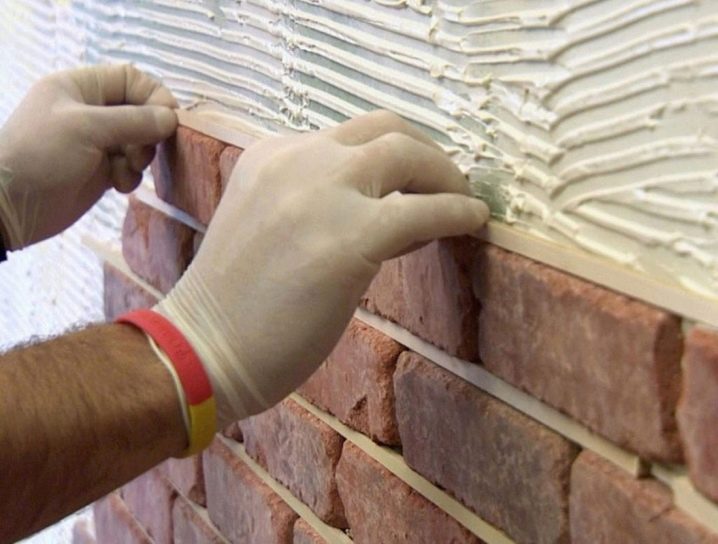
Hallway design examples
A corridor or hallway is one of the most frequently decorated rooms with decorative bricks. Here are some examples of how this cladding can be applied in such a difficult room.
A white wall, completely lined with decorative bricks, visually expands the space in a narrow corridor.

Decorative bricks can even decorate the door, thereby hiding it, uniting it into one piece with the wall.

Brickwork can only be in a niche and is an excellent base for paintings or other similar accessories.
Fragmented masonry on the wall in the hallway will cover the place that is very likely to get dirty.
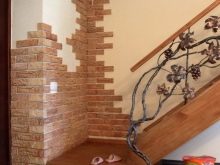
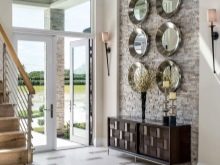
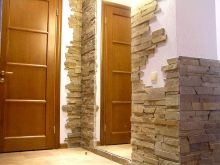
Beautiful ideas in the interior
The urban style in the hallway of a modern home is quite appropriate. Here the street with the carriageway depicted on the door turns into the brick wall of the building, which is part of the corridor.

The wall, finished with aged white brick, combined with metal shelves for the garage, gives a rather interesting and functional loft-style hallway interior.
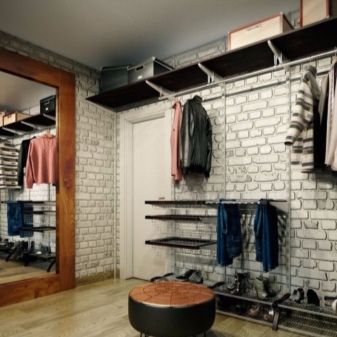
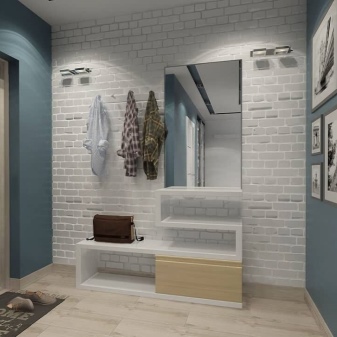
The brutal design of a gray wall with a fragment of brickwork contrasts with a glamorous purple velvet banquet - a rather bold and original interior for decorating the corridor.
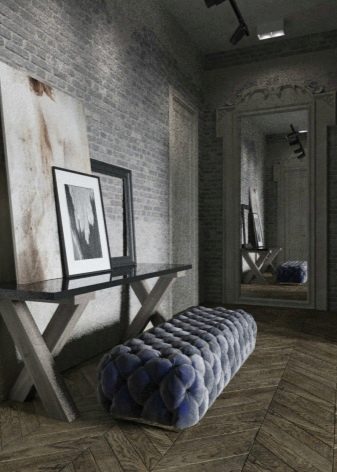
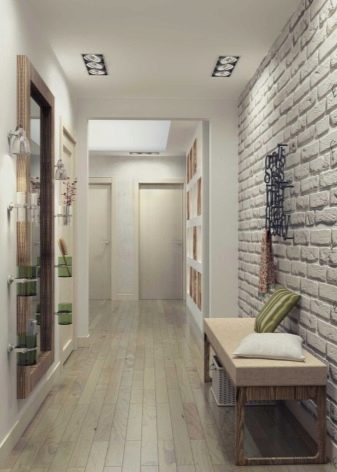
See below for more details.













The comment was sent successfully.